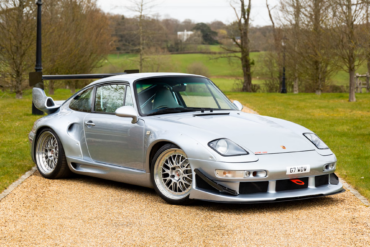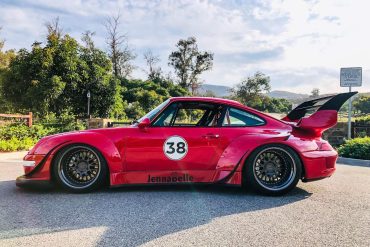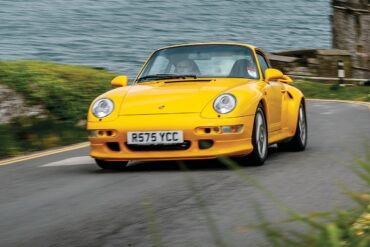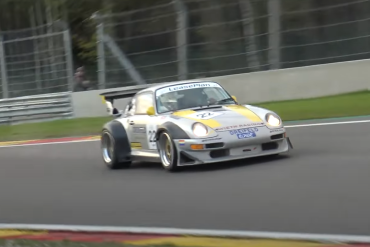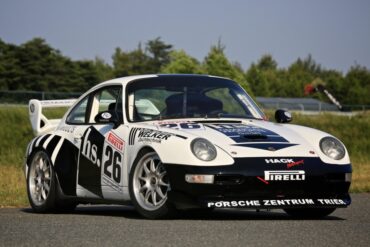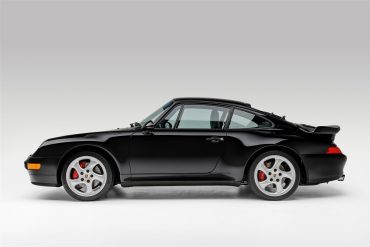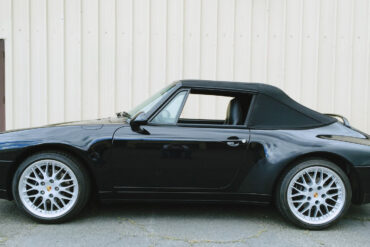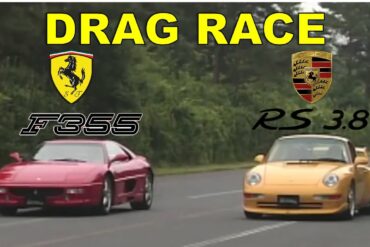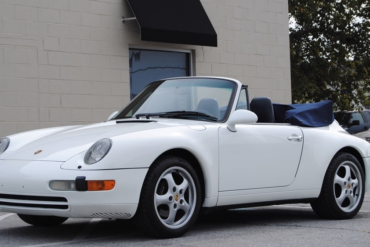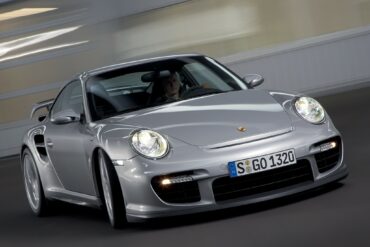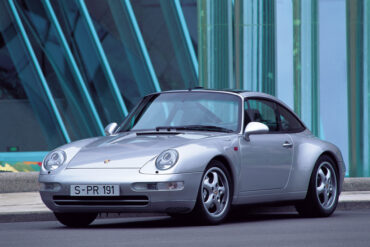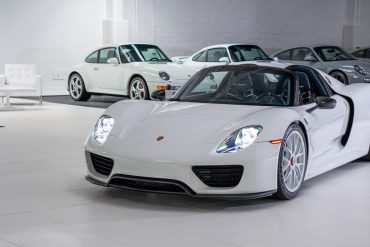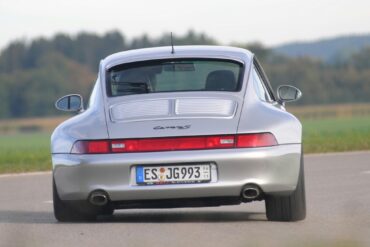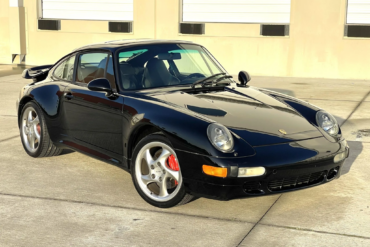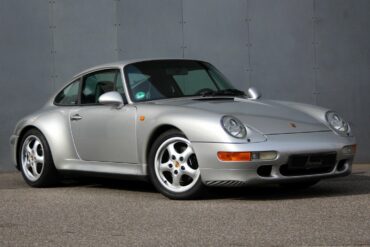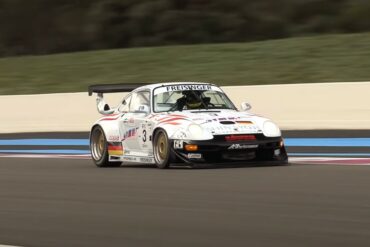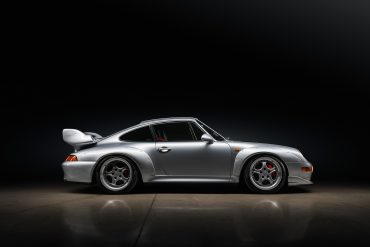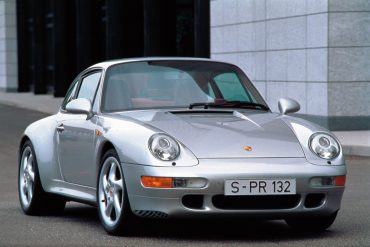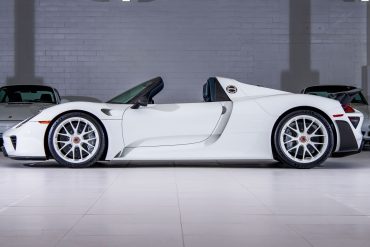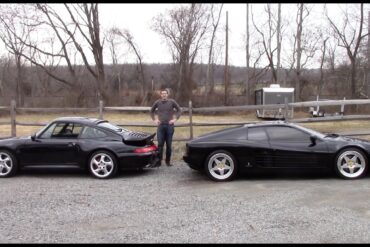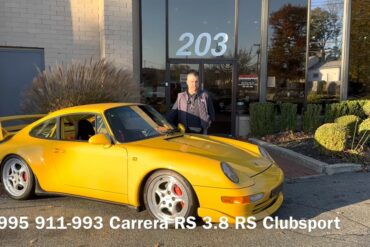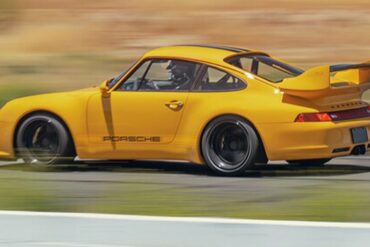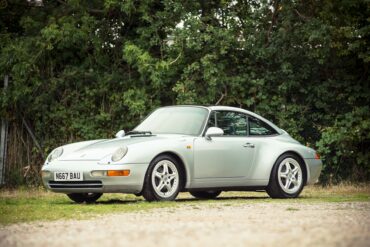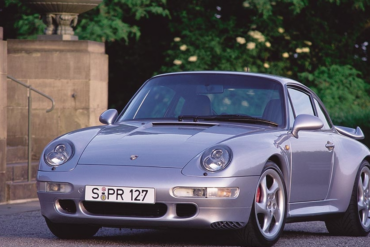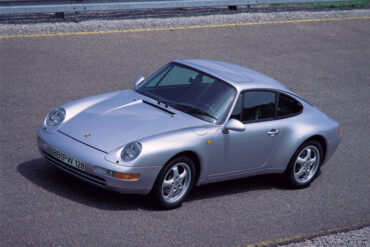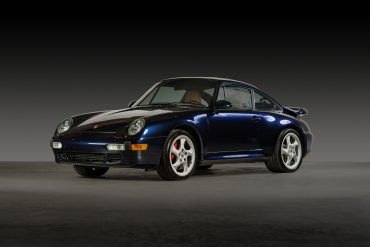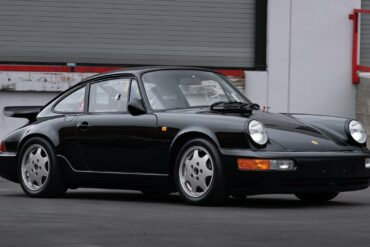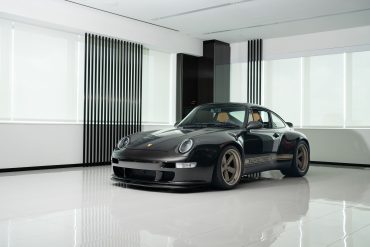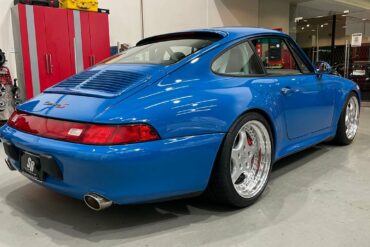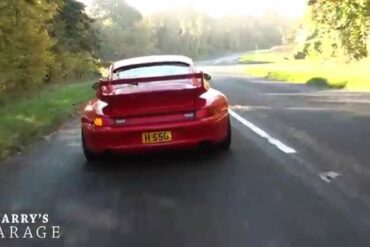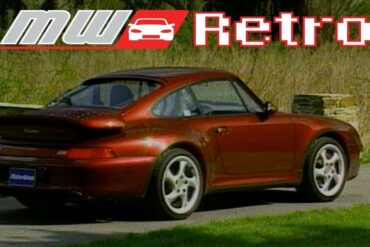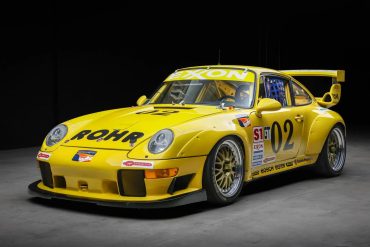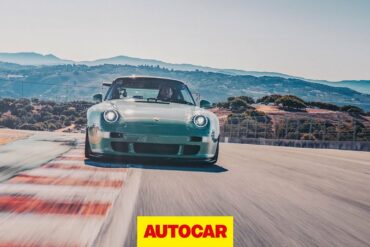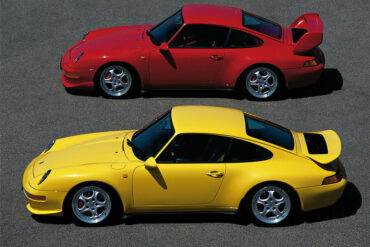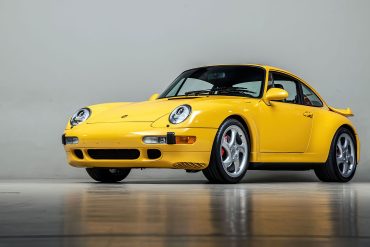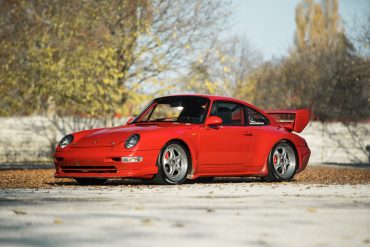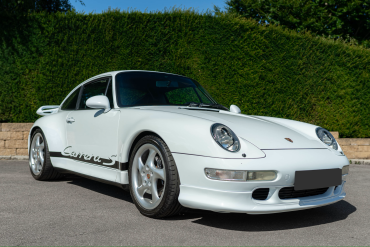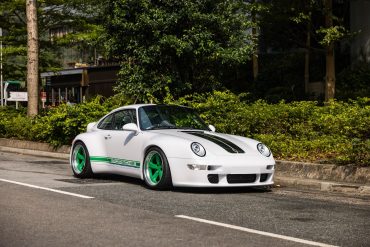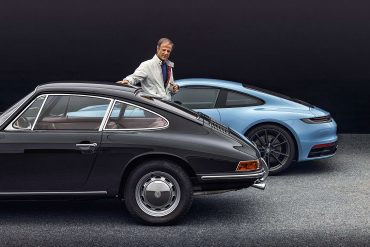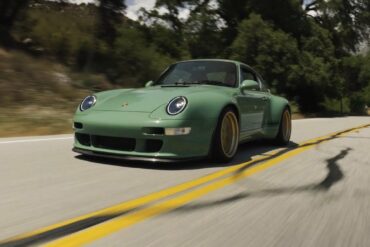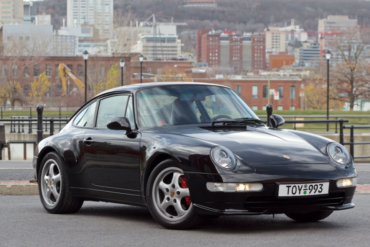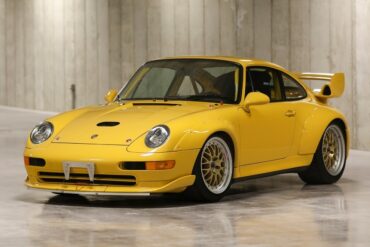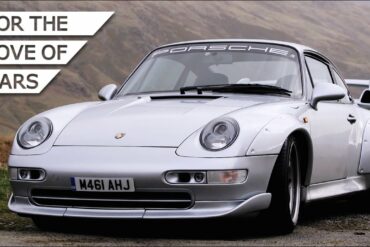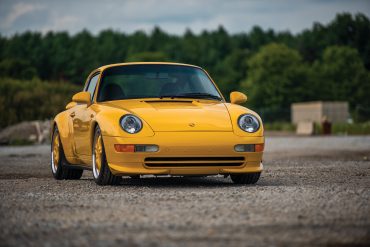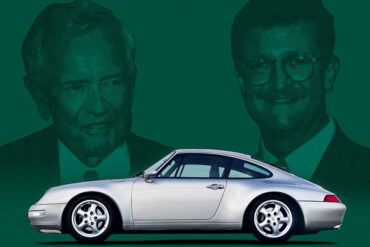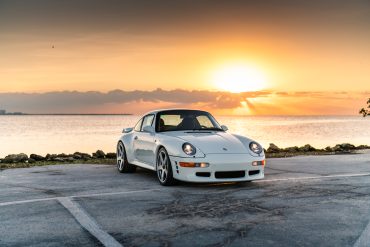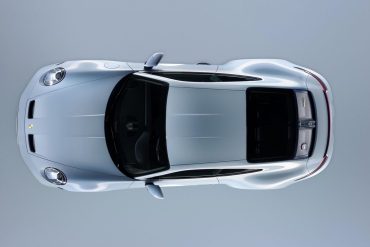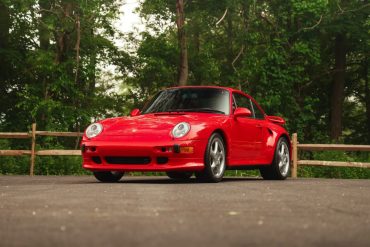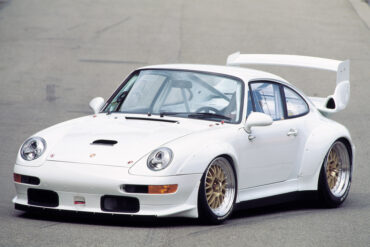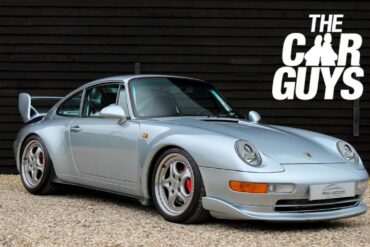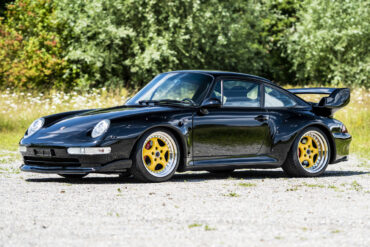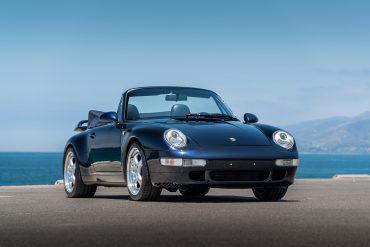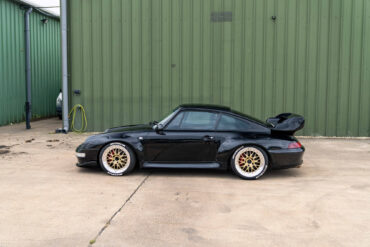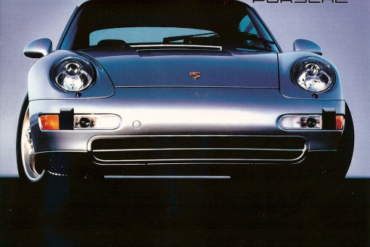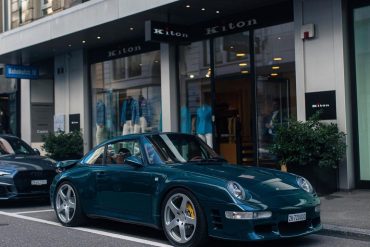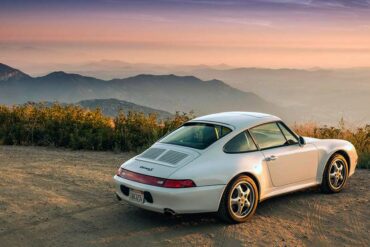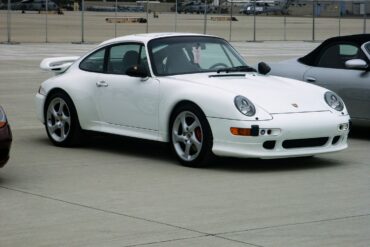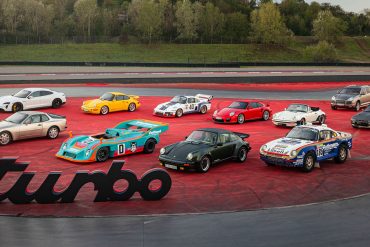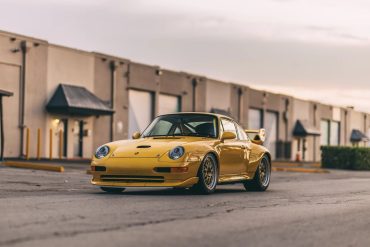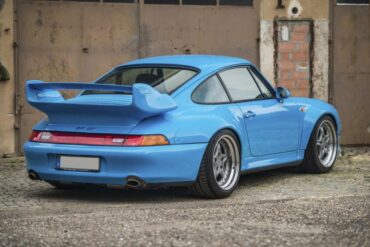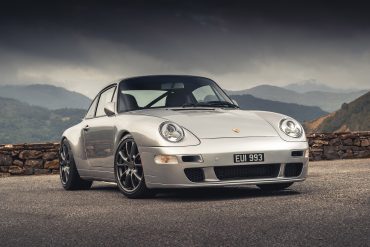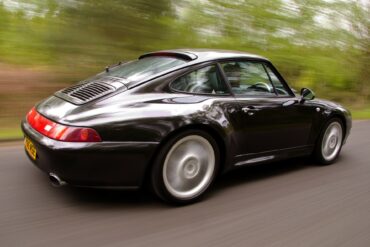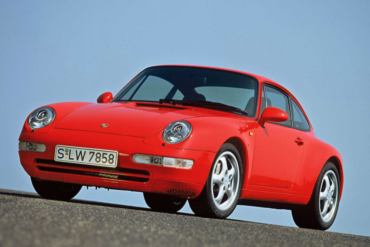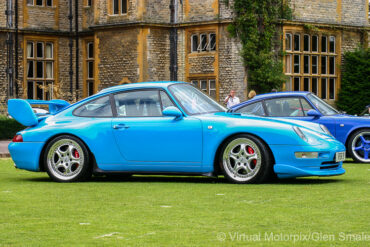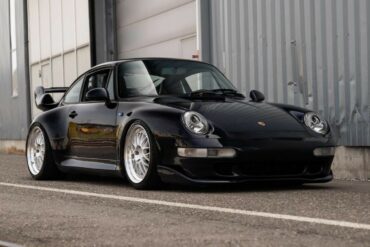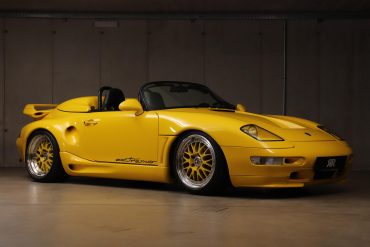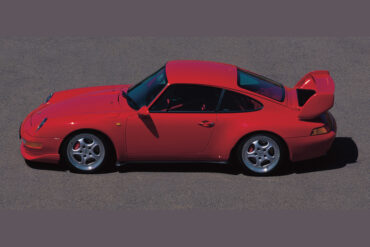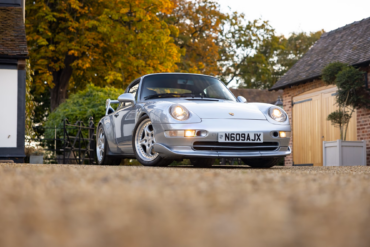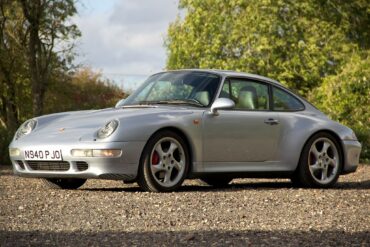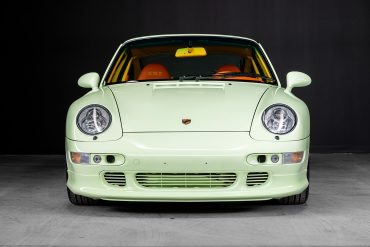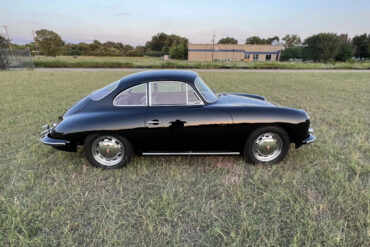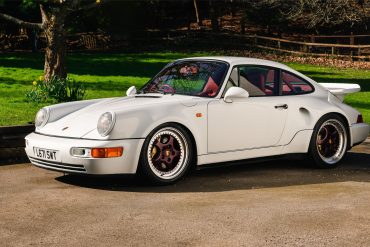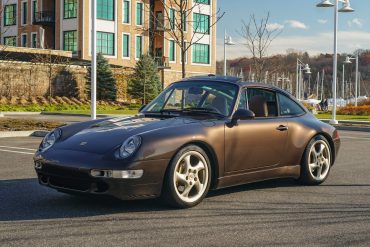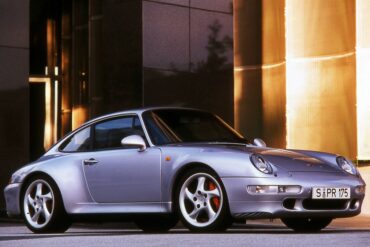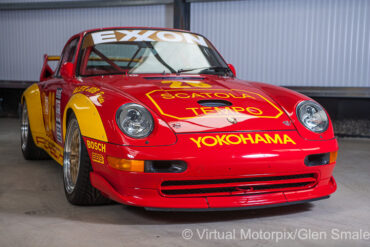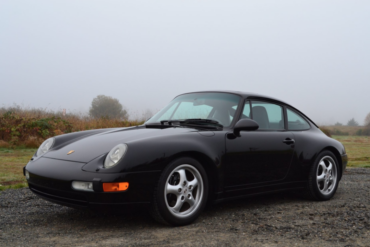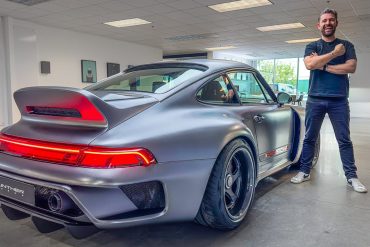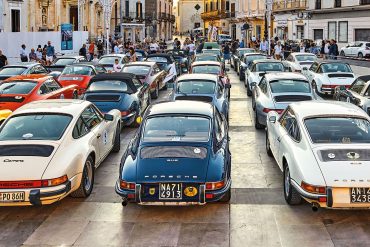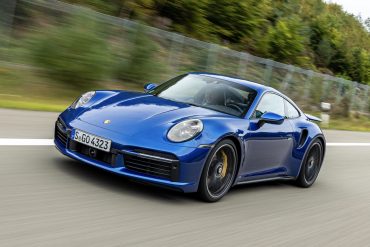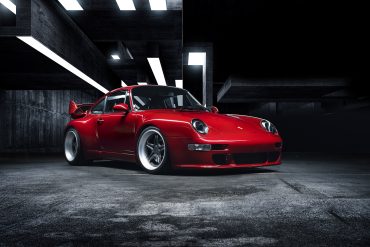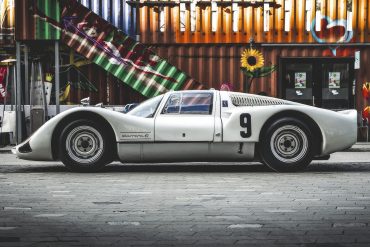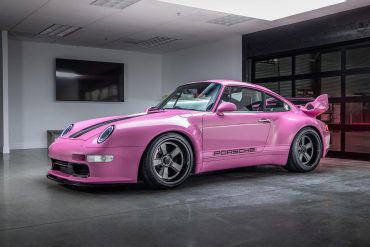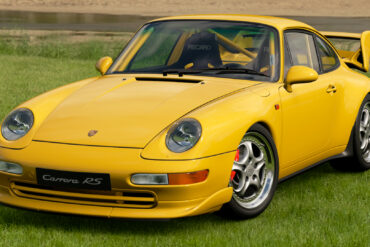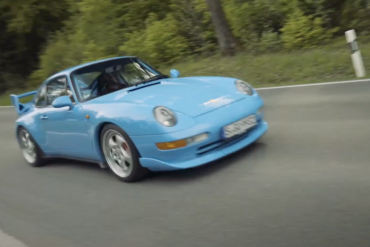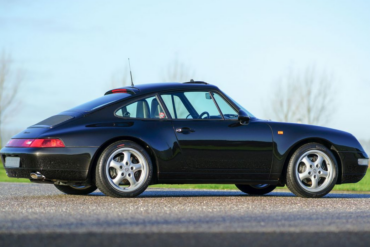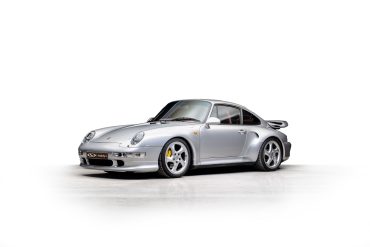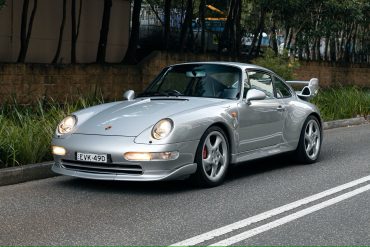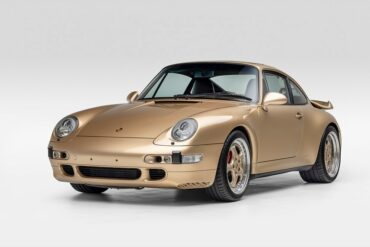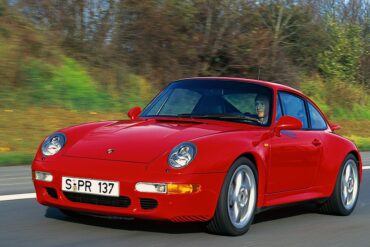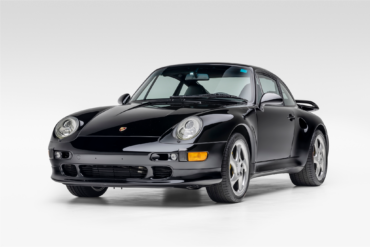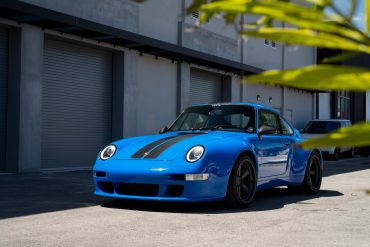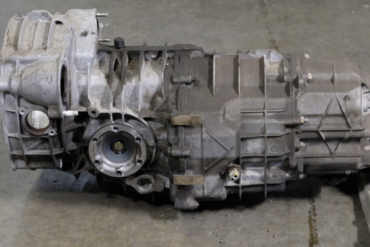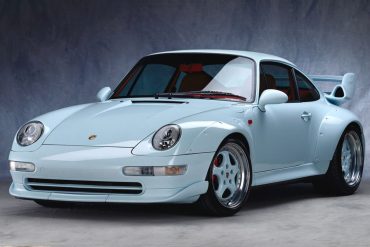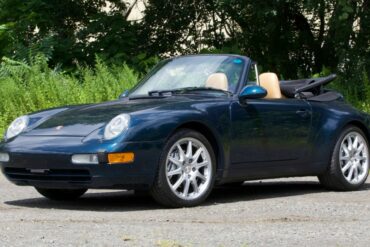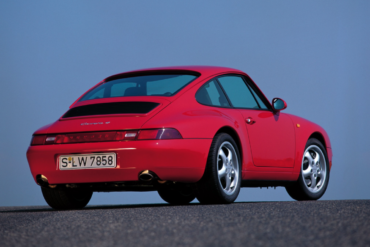Gemballa, located in Leonberg, Germany, near Stuttgart, has been modifying Porsches since 1981 when the founder, Uwe Gemballa, established the...
Porsche 911 (993)
In 1993 the Porsche 993 Carrera was presented to the general public as the successor for the 964. The Porsche 993 was the fourth generation of the Porsche 911 and easily the most loved iteration and the last of the aircooled Porsche 911s. It was more sophisticated and durable than the Type 964 that came before it, the significant technical advances in the underpinnings created a more civilized car and a greatly improved handling experience too. The 993 retained the 3.6 L m64/01 engine from the 964 but it was re-designated as M64/05. The 993 Porsche 911 Carrera was introduced in Coupé and Cabriolet form in 1994. The Targa version followed for the 1996 model year. A year later came the Carrera 4, again in both Coupé and Cabriolet body styles. See all of our Porsche 993 Research.
The third example commissioned at Rauh-Welt Begriff Los Angeles, “JennaBelle,” was individually crafted according to custom specifications by RWB’s founder,...
1997 Porsche 911 Turbo S (993) Technical Specifications Engine Type Flat 6 Induction Twin-turbocharged Cooling Air/oil-cooled Valvetrain Single overhead camshaft...
The Porsche 911 GT2 Evo represented the top specification ever produced for any air-cooled Porsche. Designed to compete in FIA...
993 Carrera Cup Champions & Results 993 Carrera Supercup 1994 Uwe Alzen Emmanuel Collard Jean-Pierre Malcher 1995 Jean-Pierre Malcher Jürgen...
You have less than two hours to decide if you’ll get this 1997 Porsche 911 Turbo from Bring A Trailer...
1998 Porsche 911 Carrera Cabriolet (993) Technical Specifications Engine Type Flat 6 Induction Naturally Aspirated Cooling Air/oil-cooled Valvetrain Single overhead...
Ferrari F355 vs Porsche 911 Carrera 993 RS 3.8 Drag Race From a Japanese car show in the 1990s, an...
1995 Porsche 911 Carrera Cabriolet (993) Technical Specifications Engine Type Flat 6 Induction Naturally Aspirated Cooling Air/oil-cooled Valvetrain Single overhead...
The 2008 Porsche 997 GT2 is the most powerful and fastest roadgoing 911 Porsche has ever created. Power for the 997 GT2 comes from a 3.6 litre, twin-turbo, flat-6 cylinder engine which develops 530 bhp @ 6500 rpm, and a tire destroying 505 lb-ft of torque @ 2200 - 4500 rpm. most of the power gains have been achieved with changes to the turbo-charging system and the addition of a high-flow titanium exhaust system. Power is transferred to the rear wheels of through a 6-speed manual giving the car a 0-60 mph time of just 3.6 seconds and a 204 mph top speed.
The Targa was the half-convertible bodywork offered by Porsche for the 911. By removing only a part of the roof and leave the closed-coupe rigid structure. It was offered a better sensation than a sunroof and it wasn't as heavy as a convertible. Unlike the previous Targa generation, the 993 featured a glass panel over the front passengers instead of a fabric one. The rest of the bodywork looked similar to the Carrera. The engine was a completely reworked flat-six, with a 3.6-liter displacement with the VarioCam system, which offered 285 hp. It was mated either with a 6-speed manual or a 4-speed automatic.
You already read about our preview of The White Collection auction here on Stuttcars. Fifty-five Porsches, mostly in white, with...
1998 Porsche 911 Carrera S (993) Technical Specifications Engine Type Flat 6 Induction Naturally Aspirated Cooling Air/oil-cooled Valvetrain Single overhead...
The Porsche 911 Turbo also known as the 993 was available between late 1995 to 1998. Powered by a twin-turbocharged...
The Porsche 911 is a legendary car, and the RS trim represents the pinnacle of on-track performance. But how does...
Porsche 911 (993) Paint Color Options This post outlines all the color options for the 993 generation Porsche 911 over...
Ruf’s follow-up to the iconic “Yellowbird” debuted in 1995, based on the new 993 Turbo chassis. Maintaining the original’s themes...
The racing sportscar is prepared by Porsche following the Le Mans GT2 regulations for the over 1,150 kg weight classification. It features a 3.6-litre engine with two turbo-chargers (KKK 24 with 33.8 mm restrictors), which delivers around 450 hp at 5,750 rpm. Even this racing vehicle, with its suspension featuring a McPherson front axle and Porsche multi-link rear axle with LSA system, closely resembles its production relative. Utilizing a steel 993 Twin Turbo chassis with modifications for racing, scored numerous victories in a wide variety of racing venues.
The 993 Porsche 911 GT2 (or GT as it was initially called) was built in order to meet homologation requirements...
The Carrera S was the ultimate, naturally aspirated version of the Carrera 2. Porsche decided to offer something more to its customers when it launched the Carrera S version. It featured a stiffer and lowered suspension. Its wider tires made it better in the corners and faster around a race-track than its Carrera 2 sibling. The Carrera S took its bodywork from the Porsche Turbo. But it didn't get the turbocharger or the all-wheel-drive system. Its wider rear fenders and lowered stance than the Carrera lineup made it a desirable car for the Porsche fans. The engine was the same 3.6-liter naturally aspirated, but it was offered in the higher power output of 285 hp. The only transmission available was a 6-speed manual.
As the Porsche market continues its strong trajectory, RM Sotheby’s is thrilled to unveil “The White Collection” auction—a unique gathering...
Head to Head – Doug DeMuro Picks His Favorite Doug DeMuro compares two 1990s icons — the Ferrari 512TR and...
Featuring the Speed Yellow finished Factory Clubsport 1995 911/993 Carrera RS 3.8 Clubsport. Concours-ready, 1 of only 227 examples built,...
A Legend Remastered, Driven by Randy Pobst Randy Pobst gets behind the wheel of Gunther Werks’ Remastered 993 and dives...
1998 Porsche 911 Targa (993) Technical Specifications Engine Type Flat 6 Induction Naturally Aspirated Cooling Air/oil-cooled Valvetrain Single overhead camshaft...
Dubbed the “Chelsea Grey Commission,” this 1996 Porsche 911 Carrera is the first of 25 units produced by Gunther Werks...
1996 Porsche 911 Turbo (993) Technical Specifications Engine Type Flat 6 Induction Twin-turbocharged Cooling Air/oil-cooled Valvetrain Single overhead camshaft Injection...
Porsche Option Codes – Porsche 911 Type 993 (1994 Model Year) Looking to decode your 1994 Porsche 911 option codes?...
This is the last of the aircooled 911 turbos. Porsche introduced the Turbo for the 1995 model year. It had...
Porsche Option Codes – Porsche 911 (1996 Model Year) Looking to decode your 1996 Porsche 911 option codes? Want to...
The “Carbon Noire Commission” is a remastered version of the 911s based on the 933-generation by Gunther Werks. The car’s...
A Modern Take On A Timeless Carrera Welcome back to one of SR Auto Group’s first episodes on refreshing a...
Harry’s Garage Reviews A Porsche 911 993 ‘GT2’ Evo Starting life in 1995 as a regular 993 turbo, this car...
Motorweek’s Original Porsche 911 Turbo (993) Review The 993 Turbo is widely referred to as the “True Purist’s Holy Grail.”...
Developed by Porsche to fulfill FIA GT racing homologation requirements, the 993 GT2 was derived from the 993 Turbo. It...
Autocar Drives the Gunther Werks 993 And in this vid is a rather serious take on the theme. California-based Gunther...
1995-1996 Porsche 911 Carrera RS 3.8 (993) Technical Specifications Model Porsche 911 Carrera RS 3.8 (993) Model Years 1995 and...
The Porsche 911, the undisputed king of sports car evolution, has continued to be transformed since its 1963 debut. One...
The Carrera RS Clubsport, a track-oriented variant of the Carrera RS, prioritized performance over road comfort. Featuring a fully welded...
Collecting Cars is currently offering a well-maintained and highly original 1997 Porsche 911 (993) Carrera S. This example is finished...
Gunther Werks, established in 2017 by the team behind Vorsteiner, took the iconic air-cooled Porsche 993 and crafted a modern...
Evolution, not Revolution Since its debut in 1964, the Porsche 911 has epitomized engineering evolution. Conceived by Ferdinand “Butzi” Porsche,...
The Gunther Werks 993 The Drive returns to the Gunther Werks headquarters to get an insider’s look at the new...
1995 Porsche 911 Carrera 4 (993) Technical Specifications Engine Type Flat 6 Induction Naturally Aspirated Cooling Air/oil-cooled Valvetrain Single overhead...
1996 Porsche 993 GT2R Sold for $665,000 This yellow beauty sold at Pebble Beach by Gooding & Company for a...
Porsche 911 (993) GT2 Driven Charles Morgan takes us through one of his favourite cars – the 911 993 GT2....
The 993 generation gave us some great Porsches. You had the 993 Turbo which was a straight line weapon and...
PORSCHE 993 “25 YEARS” 1994–2019: by Andreas Gabriel, Manfred Hering & Thomas Nehlert © Berlin Motor Books Berlin Motor Books,...
Starting as a modest service station in Pfaffenhausen, Germany, within a mere three decades, RUF quickly evolved into a hub...
In the beginning… The engine of the Porsche 911 has come a long way over the past 60 years, now...
The final air-cooled 911 Turbo from Porsche was the Type 993 Turbo S, offering a remarkable conclusion to that era....
The Porsche 911 GT2 Evo represented the top specification ever produced for any air-cooled Porsche. Designed to compete in FIA GT1, it incorporated a twin turbocharged 3.6L flat-6 engine rated at a full 600 HP and 491 lb-ft of torque. As compared to the standard 993 GT2, Porsche widened the rear fender extensions to cover wider modular wheels and added a new front spoiler with inlets for oil and brake cooling. A second deck appeared on the already outlandish rear spoiler, which could be mounted higher in the air stream for added downforce. Approximately 11 samples were produced.
This week Jason takes a trip down to Ashgood Classic and Sports Cars to test drive an iconic Porsche, the...
The GT2 was the hardcore, race-focused version of the 993 Turbo, using essentially the same 3.6 L twin-turbocharged engine, but slightly modified with increased power output. The car was made to compete in the FIA GT2 racing class. Among this already very exclusive circle of 57 cars there is an even more rare community. 20 of the 57 road-legal cars were produced in a second – and last – badge with upgraded engine power (450 PS) called GT2 “Clubsport” which make them the last Porsche models with air-cooled engines.
While the 911 Turbo Cabriolet has become a common sight since the 996 generation, the 993 Turbo Cabriolet is a...
In 1993, Porsche introduced the Type 993, considered by many as the most beautiful 911. After years of aerodynamic and...
Collecting Cars is currently offering an impressive 24-car collection of rare exotics by a single owner which houses several Porsches....
Porsche 911 Sales Brochures (Type 993) After lots of digging and searching, we have found only two Porsche sales brochures...
Ruf released the Turbo R Limited in 2016, paying homage to the original Turbo R. Only seven units were produced,...
Porsche Option Codes – Porsche 911 (1997 Model Year) Looking to decode your 1997 Porsche 911 option codes? Want to...
1994-1998 Porsche 911 (993) Carrera, Carrera S, Carrera 4, Carrera 4S, Turbo Service Schedule This maintenance service schedule checklist is...
A visit to Porsche at the Retro Classics in Stuttgart is always a journey through time. This year, the sports...
The demise of the FIA World Sportscar Championship in 1992 left a void in international GT racing, but the emergence...
1995 – 1996 Porsche 911 GT2 (993) Technical Specifications Type Racing Car Built At Germany Engine Flat-6 Position Rear Longitudinal...
The Autoart 993R is a tribute to the driving experience of a 911. It brought together the narrow-bodied, air-cooled 993-series...
1997 Porsche 911 Carrera S (993) Technical Specifications Engine Type Flat 6 Induction Naturally Aspirated Cooling Air/oil-cooled Valvetrain Single overhead...
1995 Porsche 911 Carrera (993) Technical Specifications Engine Type Flat 6 Induction Naturally Aspirated Cooling Air/oil-cooled Valvetrain Single overhead camshaft...
It is forty years since the introduction of Porsche’s first RS, the mighty Carrera RS 2.7, back in 1973. For...
This Swiss based 993 Turbo looks like it has some really nice touches. The perfect stance....
The Porsche you see here is an exceptionally beautiful car and one of just two ever created by Gemballa GmbH,...
The 993 Carrera RS Clubsport, 213 of which were built to meet the FIA GT2 homologation requirements, is a race-ready, although street legal variant of the 993 Carrera RS, not to be confused with the track only 993 Carrera Cup RSR. Emphasizing its competition credentials, the 993 Carrera RS Clubsport came with a welded-in roll cage as standard, considerably increasing its rigidity, racing bucket seats, six-point safety harnesses, battery isolator switch, fire extinguisher, and a huge fixed rear wing, the latter also available on the 'base model' Carrera RS.
The Carrera RS 3.8 is the ultimate lightweight special edition 911 variant of the 993 Carrera generation. It featured a...
1997 Porsche 911 Carrera 4S (993) Technical Specifications Engine Type Flat 6 Induction Naturally Aspirated Cooling Air/oil-cooled Valvetrain Single overhead...
This 993-generation Porsche 911 Turbo S is the result when an unlimited budget accompanies extreme fantasy. There’s no other way...
Some pretty interesting Porsches are currently being offered at Bring A Trailer at No Reserve: a 1964 Porsche 356C Coupe,...
A perfect parade of pristine Porsche 911’s is set to be a star draw at the Salon Privé Club Trophy...
This 1996 Porsche 993 Carrera Targa, one of only 462 units produced for the U.S. market in its model year...
1996 Porsche 911 Carrera 4S (993) Technical Specifications Engine Type Flat 6 Induction Naturally Aspirated Cooling Air/oil-cooled Valvetrain Single overhead...
The 993 Carrera RSR takes the 993 Carrera RS formula and makes it even more track-ready by adding a roll-cage and removing carpet, power windows, and a/c. There were just thirty Porsche 911 Cup 3.8 RSR (Type 993) race cars produced for the 1997 season. This model was the last of the breed of air-cooled, naturally-aspirated 911 race cars to come from the Weissach race department before the introduction of the Type 996 water-cooled cars. To find a 993 3.8 RSR that participated in some of the world’s toughest endurance races in period, and survived unscathed and unmolested, is quite rare.
Porsche 911 (993) Technical Specifications & Model Comparison (European Variants) European specs 911 993...
A couple of days ago, California-based specialist Gunther Werks revealed their latest creation, the Touring Turbo Edition Coupe, at The...
“To hell with the timing. This is more important,” Wilfried Reinhardt says to himself. He hesitates for just a moment,...
To date, 27 different variants make up the current generation of the 911 model line-up. Chatting to its developers at...
The Gunther Werks 400R is a modern version of Porsche’s last air-cooled 911 and is the first car from the...
Background In the Porsche world, “Luftgekühlt” represents all the air-cooled cars in the manufacturer’s history, from the Pre-A 356 through...
Gunther Werks, a California-based Porsche specialist, has unveiled an awe-inspiring restomod of the Porsche 911 (993) at the esteemed Goodwood...
1995-1996 Porsche 911 Carrera RS 3.8 Clubsport (993) Technical Specifications Model Porsche 911 Carrera RS 3.8 (993) Model Years 1995...
I have always been a big fan of Ben Barry and his reviews, so it was nice to stumble upon...
1996 Porsche 911 Carrera (993) Technical Specifications Engine Type Flat 6 Induction Naturally Aspirated Cooling Air/oil-cooled Valvetrain Single overhead camshaft...
In 1997, Porsche produced a limited factory-production run of what is the last air-cooled 911 Turbo, the 993 Turbo S....
The Porsche 993 Turbo, introduced during the 993 generation of the 911, revolutionized the sports car landscape. With a 400...
The 993 Turbo was available between late 1995 to 1998. Powered by a twin-turbocharged 3.6 liter flat six, it was...
Porsche Option Codes – Porsche 911 (1998 Model Year) Looking to decode your 1998 Porsche 911 option codes? Want to...
In 1997, Porsche produced a limited factory-production run of what is the last air-cooled 911 Turbo, the 993 Turbo S....
While many have modified the 911 over time, Gunther Werks stands apart, envisioning a scenario where Porsche continued refining the...
Porsche 911 (993) Transmission Codes The transmission number code is found on the transmission data plate. There were two codes...
Almost 60 years after the final race, Solitude Revival from 22 to 23 June 2024 harks back to the motorsport...
This bespoke Porsche 993 is no stranger to the Porsche world, though very few people are likely to have ever...
1995 Porsche 911 Carrera 4 Cabriolet (993) Technical Specifications Engine Type Flat 6 Induction Naturally Aspirated Cooling Air/oil-cooled Valvetrain Single...
1997 Porsche 911 Carrera 4 (993) Technical Specifications Engine Type Flat 6 Induction Naturally Aspirated Cooling Air/oil-cooled Valvetrain Single overhead...


